Sidebar
Table of Contents
BW-VTOLT "Hammer"
The Hammer was designed, and developed by Section 6 in YE 41 as a “workhorse” space capable craft to be used by their air/space support units. It features interchangeable rear modules similar to the Ge-E1-1a - Tenba-Class Transporter, albeit is larger in size and carrying capacity.
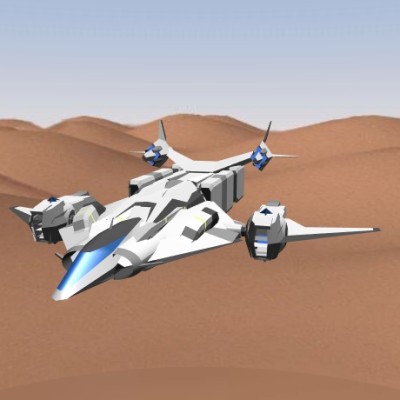
About the Hammer
The S6-VTOLT is a Vertical Take Off and Landing Transport, meaning it does not require a full runway to land on, just a cleared space only slightly larger then the craft itself. It was designed and put into service in YE 41, following a growing need for in house transports, given the ones mainly in service were third party bought and costly to replace due to construction costs and the price of long distance shipping. It is capable of carrying several different modules that attach to the rear of the craft. Each serves a different purpose, and can be simply uncoupled from the hull, and swapped with another. Other wise the vehicle acts as a cargo carrier, carrying large containers and vehicles suspended by tension cables, or coupled to the attach points.
Key Features
Important functions of this craft.
- Swap-able rear modules for different support roles.
- Space capable/ atmospheric capable craft that is rated for re-entry.
- Utility craft that acts as the workhorse of Section 6's air support.
Mission Specialization
These are the main roles this craft can fill as needed.
- Aerial combat support
- Material transportation
- Troop transportation
- Utility craft
Appearance
The Hammer is very spear like in shape with minimal blocky aspects when it comes to it's appearance. The craft is long and has three distinct sets of thrusters, with one set at the rear that are spread on stabilizing wings that rotate, another which consist of another pair of 360 rotating thrusters which these have small wings on their sides. Finally, the third run more then 50% of the ship's length towards the rear. The ports of eight missile launchers, and a twin linked rotary chaingun turret on the underside of the nose, are all that mar the other wise smooth design.
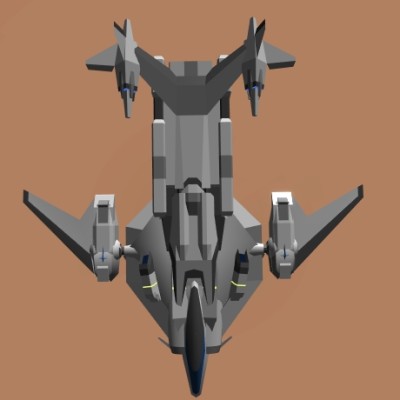
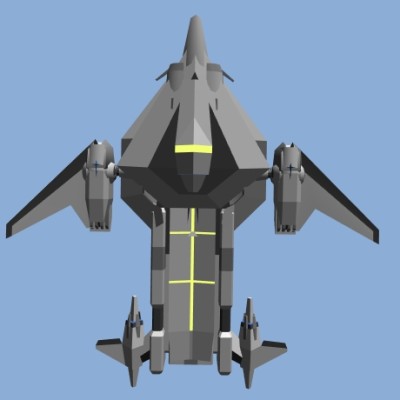
History and Background
In YE 41, Section 6 developed a new craft that would form the back bone of their aerial support force, and fit most of the major support roles a growing army needs from its air/space support units. Department Of Engineering and the Department Of Fleet Development(D.O.F.D), got together in a meeting room in the first month of the new year and looked at things their forces and government lacked, composing the a list, one such item was a utility/support focused craft that could haul large amounts of troops, cargo, or even other vehicles as needed. Thus, the Hammer was drawn up, and after several trials, entered mass production.
Statistics and Performance
General notes about the Hammer's stats and performance.
General
Here is the manufacturing data for the Hammer.
- Class: BW-UT-1A
- Type: Utility Transport
- Manufacturer: New Dusk Conclave, and Black Wing Enterprises
- Fielded by: New Dusk Conclave, Civilian Buyers
Passengers
Crew: 3 operators are recommended, 3 are required.1)
Maximum Capacity: There are accommodations for 3 people. About 5 people can fit aboard in an emergency, but the ship would be extremely cramped.
Dimensions
Here is the measurements for the craft itself.
- Length: 70 meters
- Width: 45 meters
- Height: 15 meters
- Decks: 1 (3.5 meters)
Propulsion and Range
Here is the data related to propulsion and the Hammer's FTL capabilities.
- Falcon Tunnel Drive: 0.2ly/m for a maximum of 15ly range
- Sublight Engines: .2c, mach .95
- Range: 3 weeks for supplies, 5 months for fuel
- Lifespan: 10 years without maintenance, 20 years with maintenance.
- Refit Cycle: 4 years
Damage Capacity
Inside the Ship
Below here is the descriptions of the Hammer's relatively limited and almost cramped interior.
Compartment Layouts
Below here is the description of the few compartment spaces this cramped utility craft has.
Bridge
The “bridge” is just a spacious cockpit, with three comfortable gel cushioned crash seats. They are arranged in a row in raised stepped raised pattern. The second and third chairs are raised up because of this, and reached by a series of handhold ladders. Displays are on manipulator arms which draw in around the seats after occupied by the pilots. As well as what is displayed on the canopy screen.
Cargo Storage Areas
Just behind the cot area, is short area where on one side, a row of lockers are present. The opposite wall is large built in storage bins.
Crew Cabins
Directly behind the bridge, is a confined space where three cots are arranged bunk bed style, and on the opposite side is the pilot's access to their stores of food and medical supplies. Here the pilots can take turns sleeping as they pull shifts for long trips.
Passageways
Only one narrow passageway, that is only wider then a one person width. This runs all the way from the bridge to the rear of the craft where it connects to whatever module is currently equipped. If a module is not equipped, then the rear airlock is locked, and a sealed ramp in the floor lowers for surface landings, or in a large enough hangar. Above, is an airlock with a ladder that can be lowered for space docking with stations, or other craft.
Ship Systems
Armored Hull and Hull Integrated Systems
The Hammer has a Tier 9 rated hull, that is composed mainly of Durandium Alloy, with a sub structure of ADNR (Aggregated Diamond Nanorods) and kinetic resistant gel. Additionally the hull has an outer layer of Aegium for armor. Electronic Camouflage System dispersal ports are an optional addition to the hull, for if a bit of stealth is needed in more military applications of the Hammer.
Computers and Electronics
The Hammer features like the other craft designed by S6, a graphene based computer system that has proven resistant to magnetic interference as well as static emissions unlike other computer systems. It's sturdy enough to withstand the rigorous work the Hammer was designed for, and powerful enough to handle all the computing needs of such a ship. In addition, a AI is standard as support for the pilots.
Emergency Systems
The craft features crash bags around all three pilot seats, and dispensers that fill the bridge's cabin with a crash foam, a substance that is dispensed as foam before turning to a gel like material when making contact with air. The cots have a cover that can be pulled down over them, as well additional crash bags for sleepers. A sprinkler system runs through out the corridor and compartments for fire suppression.
Life Support Systems
A oxygen purifier keeps the air breathable for up to 3 months until it's filters need to be replaced, as well as storage system for oxygen supply. Fresh air encountered when landing on livable planets, is drawn in through a vent system in the hull to refill these occasionally. Heating units are installed under the deck to keep compartments warm through out the ship.
Propulsion
The craft is pushed along by three sets of plasma based thrusters, which run off the same plasma drive, which uses 6 BW-PC-1A Plasma Core as a fuel and power source. They are designed to be highly efficient and to recycle as much fuel as possible that might otherwise have been lost as waste.
Shield Systems
The S6-VTOLT uses conformal shaped shields, which are a combination of magnetic and charged energy based fields. This protects the craft adequately from fast moving projectiles, as well as acts as an integrity field for the hull, allowing the craft to withstand additional stress.
Weapons Systems
Here are the weapons systems installed on the base craft itself. Additional weapons are based on the rear module currently attached.
- 2x Hyper-Shift Rotary Chaingun: twin linked and in a turret mounting on the underside of the craft's nose, DR 6
- 8x Orbit Jumper Missile System: 4 integrated to either side of the front of the craft and added auto loaders, DR 7
Vehicle Complement
Can only carry what can be attached to the rear cargo attach point at the rear of the ship, or if larger, by suspension cables for hauling to designated coordinates.
Modules
here is the information on any and all future modules that become available for use on the rear section of the craft.
Troop Transport Module(TTM)
This module is as the name describes, and is meant for the transport of troops and military equipment. It can hold a number of troops in its side seats, with any vehicles, or military cargo being secured in the center. A hatch at front connects to the interior of the Hammer itself, and the aft is where the large ramp for offloading is. Additional kinetic buffers are installed for allowing of less reduce in speed due to the added weight on the craft, due to the module and it's contents, for lessening turbulence on passengers.
- Length: 55 meters
- Width: 25 meters
- Height: 10 meters
- Troops capacity: 60
- Vehicles: up to two heavy tanks, or four jeep sized vehicles can fit in the center.
- Cargo: The center can fit several tons worth of cargo/supplies if not occupied by vehicles. However the front has a smaller area meant for cargo as well, and only has a ramp a third of the size of the rear ramp. The same amount of cargo can be stored here, and is only meant for such.
- Additional Weapons system: Another twin linked rotary chaingun turret like that on the nose, but installed on the aft section of the module above the offloading ramp.
- 2x Hyper-Shift Rotary Chaingun: T6
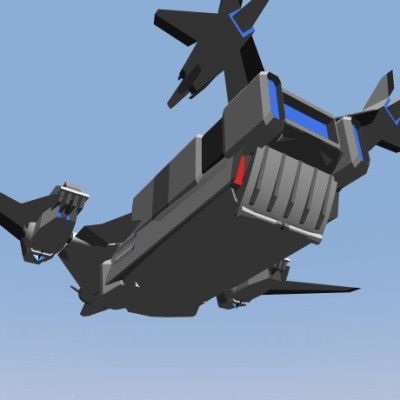
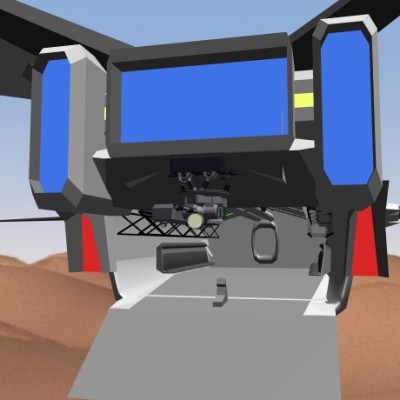
OOC Notes
Jack Pine created this article on 2018/10/14 21:49.
| Products & Items Database | |
|---|---|
| Product Categories | small craft |
| Product Name | BW-VTOLT "Hammer" |
| Nomenclature | BW-UT-1A |
| Manufacturer | Black Wing Enterprises |
| Price (KS) | 45.00 KS |
| DR v3 max | Tier 9 |
Page Tools
Terms of Service - Privacy Policy
